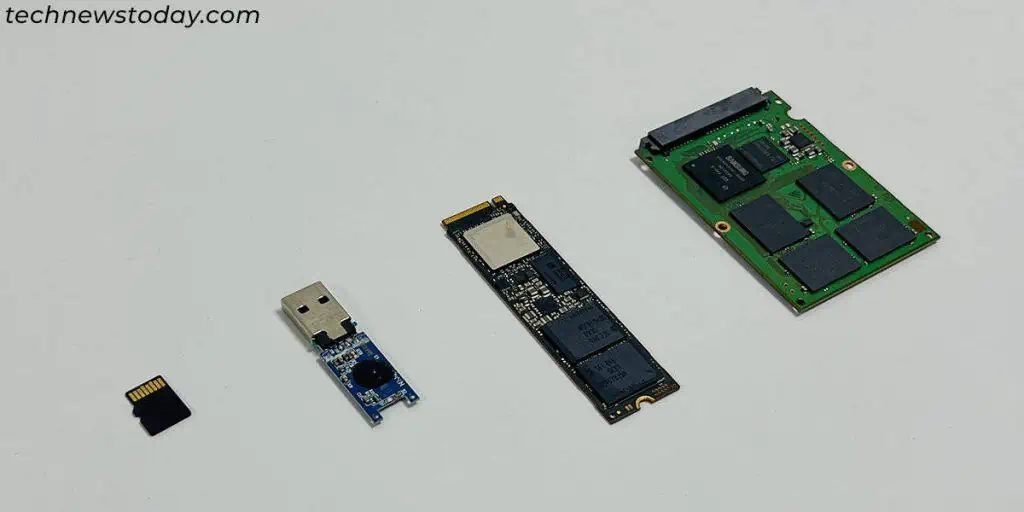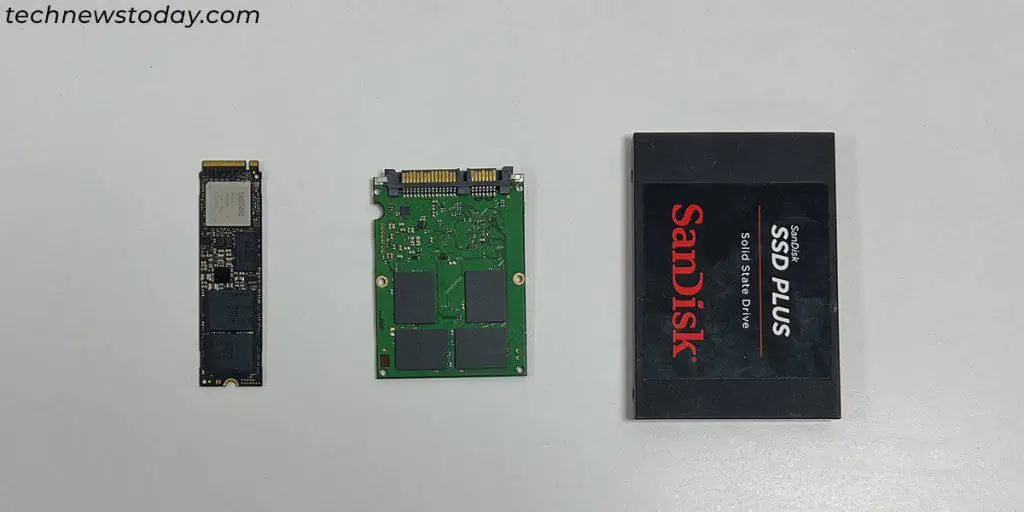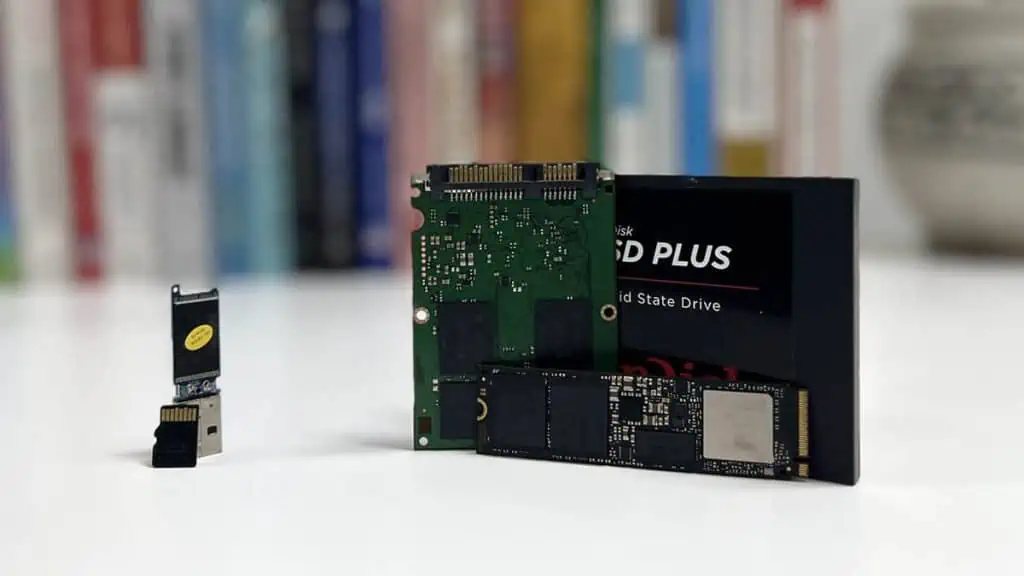In short, all SSDs are flash storage devices, but all flash storage devices are not SSDs.
SSD is a flash storage device that was designed to overcome the low endurance and performance of traditional hard disks. It has the highest performance and the largest capacity of any other flash storage media.
All flash storage media use similar technologies, but you’ll find many differences between separate devices.
In this article, I’ll be focusing on exactly how SSDs measure up to other flash storage devices.
What is Flash Storage Technology?

Flash Storage is an electrically erasable and programmable memory technology designed for high-speed read/write operations.
It is a storage technology that uses nonvolatile memory cells (floating gate MOSFETs) to store the data.
Flash memory can be either NOR flash or NAND flash. NOR performs faster read operations while NAND is faster at erasing and writing data.
Flash memory is used in several storage devices, such as:
- Solid-state Drive (SSD)
- USB Flash Drive
- SD Card
- BIOS chip
- embedded MultiMediaCard (eMMC)
The common storage and data transfer devices use NAND flash while configuration devices, like the BIOS chip, commonly use NOR flash memory.
What is a Solid-state Device?

Solid-state drive (SSD) is a type of NAND-based flash storage technology. By its name, it is clear that it has no physical moving parts and only works through the movement of electrons inside its memory cells.
While all flash storage devices work via the same principle, SSD’s name mainly exists as it was designed to replace the traditional hard disks that store data inside moving disks.
In addition to NAND flash chips, most SSDs also include DRAM which serves as a cache to speed up their performance.
While you’ll also find cheaper DRAM-less SSDs on the market, they have a lower lifespan and are much slower in comparison due to the higher use of NAND cells for writing.
SSDs are predominantly used as internal storage. You will find different types of internal SSDs depending on the connection-type and form factors, such as
- SATA SSD (2.5” and 3.5”)
- mSATA or miniSATA SSD
- M.2 SATA SSD
- M.2 NVMe SSD
- PCIe NVMe SSD
But you can also find external SSD drives that use USB adapters as an interfacing medium.
Comparison of Other Flash Storage Devices with SSD
Since an SSD is also a type of flash storage device, I’ll instead differentiate other flash storage devices with SSDs.
I’ll mainly compare M.2 NVMe/SATA SSDs with USB Flash Drives and SD Cards since these are the most common flash storage devices.
Speed
Different flash storage devices use different communication channels depending on their applicable device. Thus, they have varying levels of read/write speeds.
NVMe SSDs that get direct access to a computer’s PCIe lanes show overall higher speeds compared to other flash devices like USB flash drives, SD cards, or even SATA SSDs.
Here are the theoretical speed limits for all of these flash storage technologies depending on the generation or connection channel.
| Flash Device | Generation/PCIe Gen and Lanes | Theoretical Speed (MB/s) | Theoretical Speed w/o Overhead (MB/s) |
| M.2 NVMe SSD | PCIe 2.0 x2 | 1250 | 800 |
| PCIe 2.0 x4 | 2500 | 1600 | |
| PCIe 3.0 x2 | 2000 | 1600 | |
| PCIe 3.0 x4 | 4000 | 3500 | |
| PCIe 4.0 x4 | 8000 | 7500 | |
| PCIe 5.0 x4 | 16000 | 15000 | |
| SATA or mSATA SSD | SATA-I | 187 | 150 |
| SATA-II | 375 | 300 | |
| SATA-III | 750 | 600 | |
| USB Flash Drive | 2.0 | 60 | 40 |
| 3.0 | 625 | 450 | |
| 3.1 | 1250 | 1000 | |
| 3.2 | 2500 | 1900 | |
| SD Card | Standard/Speed class | 12.5 | |
| 312 (full-duplex), 624 (half-duplex) | 25 | ||
| Ultra High Speed (UHS-I) | 50 (full-duplex), 104 (half-duplex) | ||
| UHS-II | 156 (full-duplex), 312 (half-duplex) | ||
| UHS-III | 312 (full-duplex), 624 (half duplex) | ||
| Express | 985 (PCIe 3.1×1), 1968 (3.1×2/4.0×1), 3938 (4.0×2) | ||
*Bolded types/gens are the most commonly available at this time
In practical use, the speed for each device depends on the design, composition, and manufacturing technology.
You will usually be getting lower speed than the theoretical maximum, but between different types and generations of SSDs of similar quality, you will experience relatively proportional performance.
For instance, usual SATA or mSATA SSDs (SATA-III) have speeds of about 500–600MB/s, but there are also cheap ones with 150MB/s or lower which is like a good HDD.
For currently supported NVMe drives, you’ll get 500MB/s to 3500MB/s speeds on PCIe 3.0×4 ones and 2000-7000 MB/s on PCIe 4.0×4 ones.
Other flash devices also follow a similar pattern depending on their theoretical speeds.
Capacity
In general, SSDs comprise the highest-capacity flash storage drives that currently exist.
Here’s a comparison table that compares the currently available (as of November 2023) sizes for SSDs with USB flash drives and SD cards.
| Type of Flash Storage | Commonly Available Sizes | Largest Available Size (Consumer-level) | Largest Available Size (Enterprise/Data Center) |
| M.2 SSD | 256 GB – 2 TB | 8 TB | N/A |
| SATA SSD | 256 GB – 2 TB | 15 TB (2.5”) | 100 TB (3.5”) |
| USB Flash Drive | 8 GB – 256 GB | 2 TB | N/A |
| SD Card | 32 GB -256 GB | 1 TB | 1.5 TB |
However, keep in mind that larger is not always better. The higher capacity storage media usually provides lower performance as their manufacturers do not implement the latest speed technologies on the media to save cost.
It’s best to stick with the flash media commonly available in local hardware shops for a better price-to-performance ratio.
Durability and Lifespan
On flash storage devices, the lifespan depends on the type of NAND cells and the device usage. In general, there are three factors that determine how long an individual flash device lasts.
Program/Erase cycle (P/E cycle)
Flash memory allows to erase the data electrically from the memory cells for re-writing new data to them.
However, erasing such data causes wear and gradual degradation of the cells. So after a finite number of write/erase cycles, it is not possible to re-write to the cells.
The maximum program/erase cycle (P/E cycle) depends on the type of the NAND cells:
| Type of NAND cell | Bits of Data in a Single Cell | Max P/E Cycle per cell | |
| 2D NAND | 3D NAND | ||
| Single Level Cell (SLC) | 1 bit | 50000-100000 | N/A |
| Multi Level Cell (MLC) | 2 bit | 3000-10000 | 30000-35000 |
| Triple Level Cell (TLC) | 3 bit | 300-1000 | 1500-3000 |
| Quad Level Cell (QLC) | 4 bit | N/A | 150-1000 |
SLC is the fastest and most reliable, so it’s used in data center flash devices. MLC is also predominantly used in data centers or enterprise levels.
Most consumer-grade storage devices use TLC while some cheaper ones use QLC. This remains true for all types of flash storage devices.
Most flash devices, especially SSDs, implement wear leveling to prolong the write cycles by using all the available memory cells equally.
However, older SD cards and USB drives may not have this feature.
Data Retention
While the flash memory cells store data even without active power, the stored data will degrade over time if you store the device in a separate location. So you should never keep any flash storage device powered off for a long time.
As for power-on data retention, the storage/memory controllers regularly refresh the data without costing write-cycles.
Data retention also depends inversely on the age of the device, its workload, and usual temperature.
Physical Damage
Flash storage devices that you keep stored inside a system are not usually subject to physical damage.
However, for external media, physical endurance also affects their lifespan. So devices like USB and SD cards that can suffer from connection or pin damage are less fault tolerant compared to internal SSDs.
Price
The price for the flash storage media depends on the generation/type and is basically consistent with the speed for the same storage capacity.
I went through various online market websites and gathered the data for various consumer-grade SSDs, USB flash drives, and SD cards. The table below represents my findings.
| Flash Storage Type (1TB) | Price Range ($) |
| M.2 SSD | 45-200 (depending on PCIe Interface and Speed) |
| SATA SSD | 40-90 |
| USB Flash Drive | 90-100 |
| SD Cards | 60-450 (depending on generation, speed class, form factor and grade) |
Applications
It is not sensible to claim that one flash device is better than the other since different flash storage devices are designed and used for different purposes.
| Flash Storage Type | Applications |
| SSD | Internal and external storage for computers |
| USB Flash Drive | Portable storage for external use (usually for computers) |
| SD Card | Detachable storage for camera and Mobile devices |
| eMMC | Built-in storage for mobile devices |
It is possible to replace a few types of flash storage with another with the use of relevant adapters. For example, you can use an SD card reader to treat an SD card as a USB flash drive.
However, individual storage uses different types of connection with the computer or mobile devices. So, you may experience performance bottlenecks depending on the adapter.
Also, you can’t normally use other storage devices as a substitute for internal SSD regardless of whether it is a SATA one or an NVMe one.
